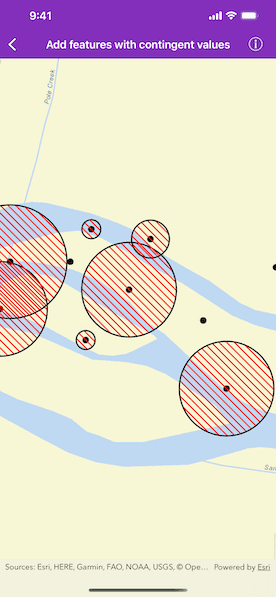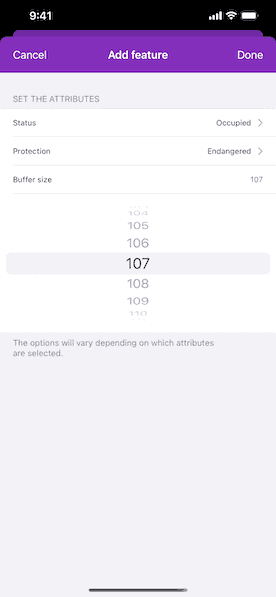Create and add features whose attribute values satisfy a predefined set of contingencies.


Use case
Contingent values are a data design feature that allow you to make values in one field dependent on values in another field. Your choice for a value on one field further constrains the domain values that can be placed on another field. In this way, contingent values enforce data integrity by applying additional constraints to reduce the number of valid field inputs.
For example, a field crew working in a sensitive habitat area may be required to stay a certain distance away from occupied bird nests, but the size of that exclusion area differs depending on the bird's level of protection according to presiding laws. Surveyors can add points of bird nests in the work area and their selection of the size of the exclusion area will be contingent on the values in other attribute fields.
How to use the sample
Tap on the map to add a feature symbolizing a bird's nest. Then choose values describing the nest's status, protection, and buffer size. Notice how different values are available depending on the values of preceding fields. Once the contingent values are validated, tap "Done" to add the feature to the map.
How it works
- Create and load the
AGSGeodatabasefrom the mobile geodatabase location on file. - Load the first
AGSGeodatabaseFeatureTable. - Load the
AGSContingentValuesDefinitionfrom the feature table. - Create a new
AGSFeatureLayerfrom the feature table and add it to the map. - Create a new
AGSFeatureusingAGSFeatureTable.createFeature() - Get the first field by name using
AGSFeatureTable.field(forName:). - Then get the field's
domainas anAGSCodedValueDomain. - Get the coded value domain's
codedValuesto get an array ofAGSCodedValues. - After selecting a value from the initial coded values for the first field, retrieve the remaining valid contingent values for each field as you select the values for the attributes.
i. Get theAGSContingentValueResults by usingcontingentValues(with:field:)with the feature and the target field by name.
ii. Get an array of validAGSContingentValuesfromAGSContingentValuesResult.contingentValuesByFieldGroupdictionary with the name of the relevant field group.
iii. Iterate through the array of valid contingent values to create an array ofAGSContingentCodedValuenames or the minimum and maximum values of aAGSContingentRangeValuedepending on the type ofAGSContingentValuereturned. - Validate the feature's contingent values by using
validateContingencyConstraints(with:)with the current feature. If the resulting array is empty, the selected values are valid.
Relevant API
- AGSArcGISFeatureTable
- AGSCodedValue
- AGSCodedValueDomain
- AGSContingencyConstraintViolation
- AGSContingentCodedValue
- AGSContingentRangeValue
- AGSContingentValuesDefinition
- AGSContingentValuesResult
Offline data
This sample uses the Contingent values birds nests mobile geodatabase and the Fillmore topographic map vector tile package for the basemap.
About the data
The mobile geodatabase contains birds nests in the Fillmore area, defined with contingent values. Each feature contains information about its status, protection, and buffer size.
Additional information
Learn more about contingent values and how to utilize them on the ArcGIS Pro documentation.
Tags
coded values, contingent values, feature table, geodatabase
Sample Code
// Copyright 2022 Esri
//
// Licensed under the Apache License, Version 2.0 (the "License");
// you may not use this file except in compliance with the License.
// You may obtain a copy of the License at
//
// http://www.apache.org/licenses/LICENSE-2.0
//
// Unless required by applicable law or agreed to in writing, software
// distributed under the License is distributed on an "AS IS" BASIS,
// WITHOUT WARRANTIES OR CONDITIONS OF ANY KIND, either express or implied.
// See the License for the specific language governing permissions and
// limitations under the License.
import UIKit
import ArcGIS
class AddFeaturesContingentValuesViewController: UIViewController {
@IBOutlet var mapView: AGSMapView! {
didSet {
mapView.map = makeMap()
// Add the graphics overlay to the map view.
mapView.graphicsOverlays.add(graphicsOverlay)
// Set the map view's touch delegate.
mapView.touchDelegate = self
}
}
let geodatabase: AGSGeodatabase!
/// The graphics overlay to add the feature to.
let graphicsOverlay = AGSGraphicsOverlay()
/// The geodatabase's feature table.
var featureTable: AGSArcGISFeatureTable?
/// The map point to add the feature to.
var mapPoint: AGSPoint?
/// The vector tiled layer to use as a basemap.
var fillmoreVectorTiledLayer: AGSArcGISVectorTiledLayer?
required init?(coder: NSCoder) {
let geodatabaseURL = Bundle.main.url(forResource: "ContingentValuesBirdNests", withExtension: "geodatabase")!
do {
// Create a temporary directory.
let temporaryDirectoryURL = try FileManager.default.url(for: .itemReplacementDirectory, in: .userDomainMask, appropriateFor: geodatabaseURL, create: true)
// Create a temporary URL where the geodatabase URL can be copied to.
let temporaryGeodatabaseURL = temporaryDirectoryURL.appendingPathComponent("birdsNestGDB", isDirectory: false).appendingPathExtension("geodatabase")
// Copy the item to the temporary URL.
try FileManager.default.copyItem(at: geodatabaseURL, to: temporaryGeodatabaseURL)
// Create the geodatabase with the URL.
geodatabase = AGSGeodatabase(fileURL: temporaryGeodatabaseURL)
} catch {
print("Error setting up geodatabase: \(error)")
geodatabase = nil
}
super.init(coder: coder)
// Load the geodatabase.
geodatabase?.load { [weak self] (error) in
let result: Result<Void, Error>
if let error = error {
result = .failure(error)
} else {
result = .success(())
}
self?.geodatabaseDidLoad(with: result)
}
}
deinit {
if let geodatabase = geodatabase {
geodatabase.close()
// Remove all of the temporary files.
try? FileManager.default.removeItem(at: geodatabase.fileURL)
// Remove the temporary directory.
let temporaryGeodatabaseURL = geodatabase.fileURL.deletingLastPathComponent()
try? FileManager.default.removeItem(at: temporaryGeodatabaseURL)
}
}
/// Called in response to the geodatabase load operation completing.
func geodatabaseDidLoad(with result: Result<Void, Error>) {
switch result {
case .success:
// Get and load the first feature table in the geodatabase.
let featureTable = geodatabase.geodatabaseFeatureTables[0]
self.featureTable = featureTable
featureTable.load { [weak self] error in
guard let self = self else { return }
if let error = error {
self.presentAlert(error: error)
} else {
// Create and load the feature layer from the feature table.
let featureLayer = AGSFeatureLayer(featureTable: featureTable)
// Add the feature layer to the map.
self.mapView.map?.operationalLayers.add(featureLayer)
// Set the map's viewpoint to the feature layer's full extent.
let extent = featureLayer.fullExtent
self.mapView.setViewpoint(AGSViewpoint(targetExtent: extent!))
// Add buffer graphics for the feature layer.
self.queryFeatures()
}
}
case .failure(let error):
presentAlert(error: error)
}
}
/// Create a map with a vector tiled layer basemap.
func makeMap() -> AGSMap {
// Get the vector tiled layer by name.
let fillmoreVectorTiledLayer = AGSArcGISVectorTiledLayer(name: "FillmoreTopographicMap")
self.fillmoreVectorTiledLayer = fillmoreVectorTiledLayer
// Use the vector tiled layer as a basemap.
let basemap = AGSBasemap(baseLayer: fillmoreVectorTiledLayer)
let map = AGSMap(basemap: basemap)
return map
}
/// Create buffer graphics for the features.
func queryFeatures() {
guard let featureTable = featureTable else { return }
// Create the query parameters.
let queryParameters = AGSQueryParameters()
// Set the where clause to filter for buffer sizes greater than 0.
queryParameters.whereClause = "BufferSize > 0"
// Query the features with the query parameters.
featureTable.queryFeatures(with: queryParameters) { [weak self] result, error in
guard let self = self else { return }
if let error = error {
// Present an alert if there is an error while querying the features.
self.presentAlert(error: error)
} else if let result = result {
// Creates buffer symbol for each feature according to its buffer size.
let newGraphics = result.featureEnumerator().allObjects.map(self.makeGraphic(feature:))
// Replace existing graphics with the new graphics.
self.graphicsOverlay.graphics.setArray(newGraphics)
}
}
}
/// Add a single feature to the map.
func addFeature(at mapPoint: AGSPoint) {
// Create a symbol to represent a bird's nest.
let symbol = AGSSimpleMarkerSymbol(style: .circle, color: .black, size: 11)
// Add the graphic to the graphics overlay.
graphicsOverlay.graphics.add(AGSGraphic(geometry: mapPoint, symbol: symbol))
// Show the attributes table view.
performSegue(withIdentifier: "AddFeature", sender: self)
}
/// Create a graphic for the given feature.
func makeGraphic(feature: AGSFeature) -> AGSGraphic {
// Get the feature's buffer size.
let bufferSize = feature.attributes["BufferSize"] as! Double
// Get a polygon using the feature's buffer size and geometry.
let polygon = AGSGeometryEngine.bufferGeometry(feature.geometry!, byDistance: bufferSize)
// Create the outline for the buffers.
let lineSymbol = AGSSimpleLineSymbol(style: .solid, color: .black, width: 2)
// Create the buffer symbol.
let bufferSymbol = AGSSimpleFillSymbol(style: .forwardDiagonal, color: .red, outline: lineSymbol)
// Create an a graphic and add it to the array.
return AGSGraphic(geometry: polygon, symbol: bufferSymbol)
}
override func viewDidLoad() {
super.viewDidLoad()
// Add the source code button item to the right of navigation bar.
(navigationItem.rightBarButtonItem as? SourceCodeBarButtonItem)?.filenames = [
"AddFeaturesContingentValuesViewController",
"ContingentValuesViewController"
]
}
// MARK: Navigation
/// Prepare for the segue.
override func prepare(for segue: UIStoryboardSegue, sender: Any?) {
// Set the controller and its properties.
if let navigationController = segue.destination as? UINavigationController,
let controller = navigationController.viewControllers.first as? ContingentValuesViewController {
controller.isModalInPresentation = true
controller.featureTable = featureTable
controller.delegate = self
}
}
}
extension AddFeaturesContingentValuesViewController: ContingentValuesViewControllerDelegate {
func contingentValuesViewController(_ controller: ContingentValuesViewController, didCreate feature: AGSFeature) {
feature.geometry = mapPoint
// Add the feature to the feature table.
featureTable?.add(feature) { [weak self] _ in
guard let self = self else { return }
let graphic = self.makeGraphic(feature: feature)
// Add the graphic to the graphics overlay.
self.graphicsOverlay.graphics.add(graphic)
}
}
func contingentValuesViewControllerDidCancel(_ controller: ContingentValuesViewController) {
// Remove the last graphic added.
graphicsOverlay.graphics.removeLastObject()
}
}
// MARK: - AGSGeoViewTouchDelegate
extension AddFeaturesContingentValuesViewController: AGSGeoViewTouchDelegate {
func geoView(_ geoView: AGSGeoView, didTapAtScreenPoint screenPoint: CGPoint, mapPoint: AGSPoint) {
guard let mapExtent = fillmoreVectorTiledLayer?.fullExtent else { return }
// Ensure that the map point is within the extent.
if AGSGeometryEngine.geometry(mapPoint, within: mapExtent) {
// Get the point on the map where the user tapped.
self.mapPoint = mapPoint
addFeature(at: mapPoint)
} else {
presentAlert(title: nil, message: "Please select a point within the layer's extent.")
}
}
}